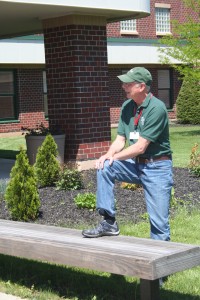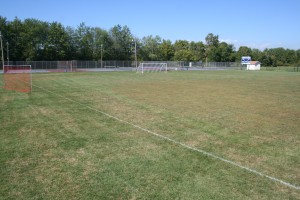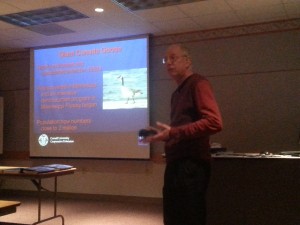The NYS Department of Health has organized a website with extensive information on school environmental health, defined as the way the physical environment of school buildings and school grounds influences the overall health and safety of occupants. The key role that IPM plays in protecting school children and staff is prominent and includes resources from the NYS IPM Program. If you have not visited the site in a while, check it out at https://www.health.ny.gov/environmental/indoors/healthy_schools/index.htm
Tag Archives: pesticide use
Pesticide Misapplications? The Costs Are High
A chemical smell wafting through an upstate middle-school classroom last fall ended up sending six students to the hospital. What happened?
A member of the custodial staff sprayed wasp killer by a fresh-air intake. Some of that spray ended up in a second floor classroom. Fourteen students and two staff members felt ill, according to a newspaper account; in fact, the school was evacuated for more than a half hour.

Need help identifying a pest and what to do about it? What’s Bugging You? has the information you need.
The school was fined $5,500 for violating three pesticide regulations. But incidents like this are preventable by practicing integrated pest management.
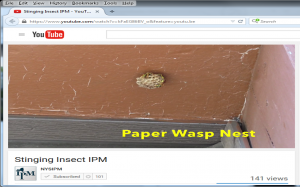
The NYS IPM Program offers resources such as this video about stinging insects and IPM strategies that reduce the risk of stings.
Many state regulations pertain to pesticide use in and around schools. You can find a synopsis here. But first and foremost — anyone who applies pesticides on school property must meet pesticide application certification requirements. (The same applies to child care centers, office buildings, or any other commercial or public property.) If the certified applicator is a school employee, then the school itself must be registered and appropriately insured.
Neither the school’s pesticide-application notification requirements nor the Child Safe Playing Fields Act were violated, since each provides exemptions for the use of small containers of aerosol products in an imminent threat from stinging and biting insects. Regardless, a certified pesticide applicator must apply them, and, if applied by a school staffer, the school must be registered.
School staffers can obtain and maintain commercial pesticide licenses after getting the right education credits and passing their exams. You can find information about pesticide certification on the Pesticide Safety Education Program website, including information about upcoming classes.
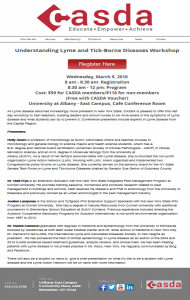
Organizations such as BOCES and CASDA often ask NYS IPMers to present at their conferences, such as this upcoming workshop on ticks and tick-borne diseases.
Consider: without the basic knowledge inherent in getting a license, how can you be sure that staff are aware of the laws that keep incidents such as this from occurring? Who will be qualified to choose a pest management contractor when the need to protect students from the threat of pests — whether increased risk of asthma from mice or cockroaches, rashes from poison ivy, or anaphylactic shock from a wasp sting — relies on an expert’s help? And how will school personnel know what steps they can take to not only deal with existing (and potentially costly) pest issues, but also prevent new ones from taking place?
Answer: Be sure your maintenance staff gets the education needed to stay up to date with the latest pest management information.
The New York State Integrated Pest Management Program has resources to help schools with their pest issues. Visit the NYS IPM Program’s school webpage. Learn about specific pests, including stinging insects. Sign up for our blog, The ABCs of School and Childcare Pest Management. Send staff to classes offered by our experts.
We are here to help address your pest management needs.
Pest Management for Today’s Schools Workshop – October 30, 2015
Do you work for a school district served by Orange-Ulster BOCES? Join the NYS IPM Program of Cornell University and Orange-Ulster BOCES for a seminar on implementing integrated pest management within schools and on the grounds.
There is no fee for the workshop, but pre-registration is requested. Contact Jack DeGraw, Health and Safety Coordinator, Orange – Ulster BOCES at john.degraw@ouboces.org or 845-781-4887.
WHERE
AGENDA
8:00 – 8:30 Registration
8:30 – 9:00 Tenets of School IPM – Lynn Braband, NYS IPM Program
Introduction to the concepts and tools for successful integrated pest management programs on school properties. Learn how to make your pest management program more efficient and effective, and how to comply with school-related laws and policies.
9:00 – 9:45 Regulatory Update – Catherine Ahlers, NYS Department of Environmental Conservation
Presentation of state regulations impacting pest management on school properties.
9:45 – 10:00 Break
10:00 -11:00 Turf and Grounds IPM – Joellen Lampman, NYS IPM Program
A discussion of IPM approaches for athletic fields, lawns, and non-turf areas such as fencelines, sidewalks, and curbs. Cultural techniques for minimizing weed populations, such as heavy overseeding, will be featured along with methods for assessing insect populations. Techniques for preventing insect and weed infestations as well as pest management products allowable for use on school grounds will be reviewed.
11:00 – 12:00 Structural Pest Management – Lynn Braband, NYS IPM Program
A description of implementing IPM for management of rodents, ants, cockroaches, and other pests in school buildings. This session will include discussions of inspections, sanitation, prevention, control options for common structural pests, and record keeping.
12:00 – 12:30 Walk-Through Exercise – Lynn Braband and Joellen Lampman, NYS IPM Program
Interactive session where we will conduct a casual on-site inspection, discussing pest management aspects of situations encountered.
What now? Autumn sports field management
“Of all the seasons, autumn offers the most to man and requires the least of him.” – Hal Borland
No disrespect to Mr. Borland, but he obviously was not in charge of keeping school athletic fields in good shape. While autumn can bring some of the best grass growing weather, when our cool season turf really thrives, it also brings students on the fields for recess, practice, physical education, and games. That can lead to a great amount of compaction and wear and tear. Combine heavy traffic with this year’s drought, and Autumn 2015 promises to be challenging.
The Child Safe Playing Fields Act was implemented in 2011 to reduce the impact of pesticides on students. While we are confident that we can reduce the impact of insects and weeds on athletic fields with good cultural practices, the Act failed to bolster school budgets, which often do not reflect the need for providing more training for staff, equipment, irrigation, and materials such as fertilizer and seed needed to produce safe fields. Without these resources, weeds, which cannot handle the same traffic as grass, can overtake a field. As the season progresses, these weedy areas become bare, leaving much more slippery and harder patches behind.
So what is the minimum that should be done now to minimize the likelihood of injury?
- Mowing -If the grass is growing, mowing should be conducted at least twice a week. Mowing increases shoot density by increasing tillering (stems that develop from the crown of the parent plant). More tillers means more traction and cushioning.
- Fertilizing -Apply 1 pound of 50% water soluble nitrogen per 1,000 sq. ft. in September and ½ pound of 100% water soluble nitrogen in mid-October. Note – if you do not have irrigation, it is worth waiting until the day before rain is predicted to ensure the fertilizer is watered in.
- Overseeding -Seed perennial rye at 2 pounds per 1,000 sq. ft. weekly in high-use areas. The athletes’ cleats will make the necessary seed to soil contact. Again, this year’s drought makes this practice tricky. If you can borrow irrigation equipment, do so.
What if I can do more than the minimum?
- Watering -Maintain adequate soil moisture but keep surfaces dry to maximize traffic tolerance. Irrigate if you can see your foot prints after walking on the turf.
- Fertilizing -Conduct a soil test to see if other nutrients are needed in addition to the nitrogen.
- Cultivating -Concentrating on high-use areas, solid tine cultivate in multiple directions to maintain infiltration of air and water.
- Overseeding -Have a mixture of one part seed to ten parts soil available so coaches and players can repair divots left after heavy use.
For more information on maintaining safe, functional athletic fields, visit http://safesportsfields.cals.cornell.edu. You will find different maintenance schedules based on number of seasons used and resources available, detailed information on different management practices, and information on “Duty of Care”, a legal obligation to a standard of reasonable care.
IPM for School Grounds Workshop – April 21, 2015
Join the NYS IPM Program of Cornell University and Wayne-Finger Lakes BOCES for a seminar on implementing integrated pest management on school grounds. Emphases will include managing quality athletic fields in light of the Child Safe Playing Field Act, developing school IPM policies, and pest situations such as weeds, grubs, stinging insects, and geese.
There is no fee for the workshop, but pre-registration is requested. Contact Kelly Wasson of Wayne-Finger Lakes BOCES at kwasson@wflboces.org or 315-597-3469.
WHERE
Canandaigua CSD Operations Center, 5500 Airport Rd., Canandaigua, NY 14424
AGENDA
7:30 – 8:00 Registration
8:00 – 8:45 Developing School IPM Policies – Lynn Braband, NYS IPM Program
8:45 – 9:30 Regulatory Update – Kelly Wasson, Wayne-Finger Lakes BOCES
9:30 -9:45 Break
9:45 -11:15 Managing Your Athletic Fields & School Grounds in Light of the Child Safe Playing Field – Jennifer Grant, NYS IPM Program
11:15 – 12:00 Managing Stinging Insects & Geese on School Grounds – Lynn Braband, NYS IPM Program

